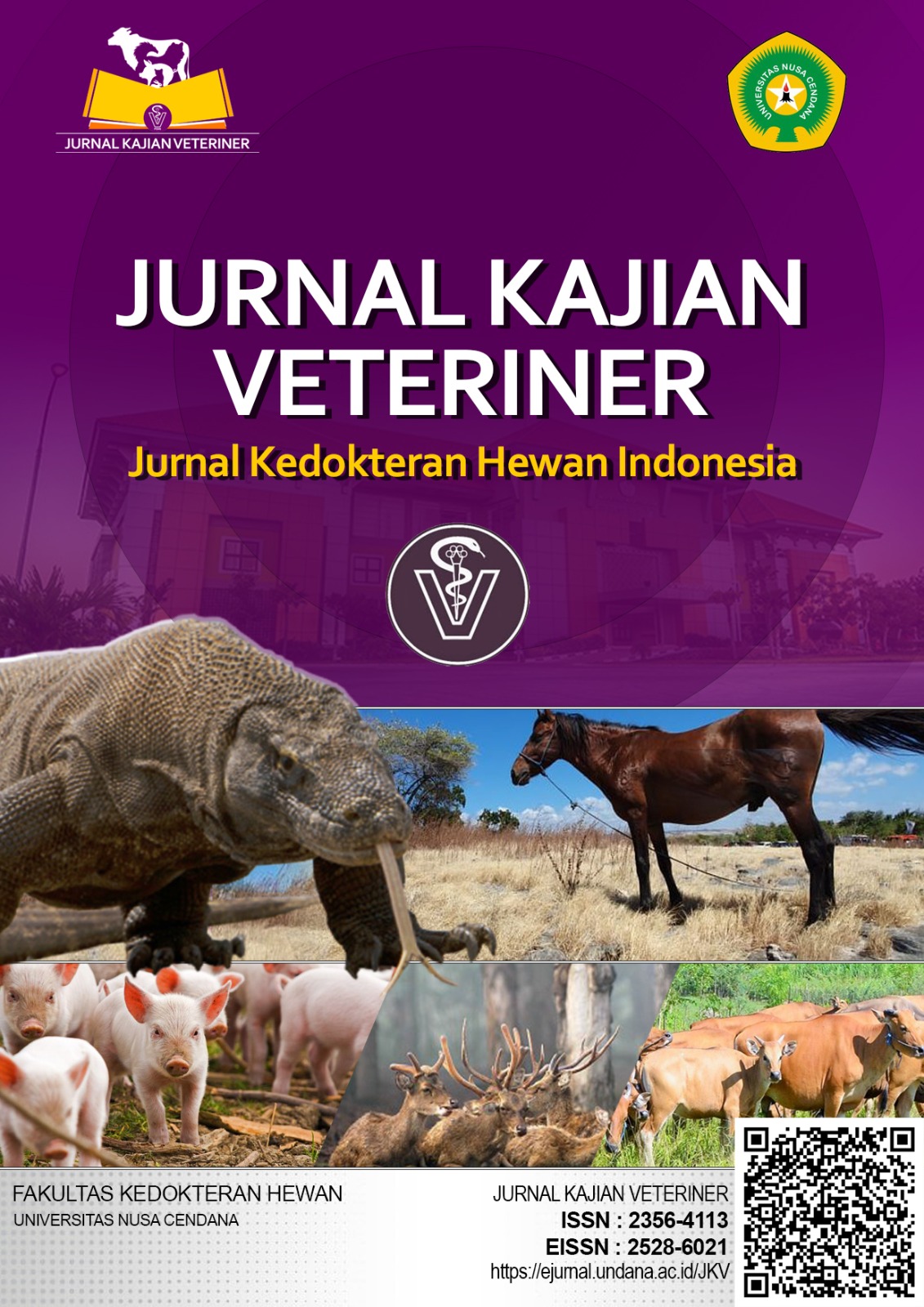Kuantifikasi Mikroorganisme dan Kelayakan Konsumsi Madu Lokal yang Diperjualbelikan di Kabupaten TTS (Timor Tengah Selatan)
Quantification of Microorganisms and Feasibility of Consumption of Local Honey Traded in TTS District (South Central Timor)
Abstract
Honey is a product of animal origin with a low water composition but rich in sugar content (fructose and glucose) which is produced through the fermentation process in honey bee hives. This study aims to look at the quantification of microorganisms and the physicochemical quality of local honey which is traded in TTS (South Central Timor) Regency. The testing technique was carried out using the TPC test for total bacterial contamination and total mold and yeast contamination, testing the physical properties of honey using heating and organoleptic testing, and testing the chemical properties of honey which included testing water content, sugar content and pH. The test was carried out on 8 honey samples taken from 3 honey-producing villages in TTS Regency, namely Loli Village, Tobaki Village, and Nenas Village. The results of the total bacteria, mold and yeast test showed that the average bacterial contamination in honey was 7.24×105 and the average mold and yeast contamination was 30.31×105, where these results exceeded the contamination limit according to SNI No.7388:2009, namely the total contamination. bacteria <5×103 colonies/g and total mold and yeast contamination <1×101 colony/g. The physico-chemical properties test was carried out to find that the physical properties of honey were not in accordance with the SNI No.01-3545-2013 and SNI No.8664:2018.
Downloads
References
Alexopoulus, C.J., Mims C.W. and Blackwell, M. 1996, Introductory to Mycology. 4th Ed. JOHN WILEY and SONS. INC., New York-Chichester-Brisbane-Toronto-Singapore.
Almasaudi, S. 2021, The antibacterial activities of honey. Saudi journal of biological sciences, 28(4), 2188.
Al-Waili, N., Salom, K., Al-Ghamdi, A. and Ansari, M.J. 2012. Antibiotic, pesticide, and microbial contaminants of honey: human health hazards. The scientific world Journal, 2012.
Ali, M. 2004. Hydrogen peroxide therapies: recent insights into oxystatic and antimicrobial actions. Townsend Letter for Doctors and Patients 255, 140–144
Ananias, K.R., Melo, A.A.M.D. and Moura, C.J.D. 2013. Analysis of moisture content, acidity and contamination by yeast and molds in Apis mellifera L. honey from central Brazil. Brazilian Journal of Microbiology, 44, 679-683.
Badan Pengawas Obat dan Makanan Republik Indonesia. 2004. Keputusan kepala badan pengawas obat dan makanan republik Indonesia Nomor: Hk. 00.05.4.2411, Badan Pengawas Obat Dan Makanan Republik Indonesia, Jakarta, pasal (1) dan (2).
Badan Standardisasi Nasional. 2013. Madu. SNI 3545-2013.
Badan Standardisasi Nasional. 2009. Batas Maksimum Cemaran Mikroba Dalam Pangan. SNI 7388:2009
Badan Standardisasi Nasional. 2018. Madu. SNI 8664: 2018
Bogdanov, S. 2009. Physical properties of honey. Dalam: Book of Honey, Chapter 4. Bee Product Science. www. bee-hexagon.net.
Baroni, M.V., Arrua, C., Nores, M.L., Fayé, P., Díaz, M.D.P., Chiabrando, G.A. and Wunderlin, D.A. 2009. Composition of honey from Córdoba (Argentina): Assessment of North/South Provenance by chemometrics. Food Chemistry 114(1): 727–733.
Carvalho, C. M., Meirinho, S., Estevinho, M.L.F. and Choupina, A.J.A.D.Z. 2010. Yeast species associated with honey: different identification methods. Archivos de zootecnia, 59(225), 103-113.
Eleazu, C.O., Iroaganachi, M.A., Eleazu, K.C. and Okoronkwo, J.O. 2013. Determination of the physicochemical composition microbial quality and free radical scavenging activities of some commercially sold honey samples in Aba Nigeria. The effect of varying colors. International Journal of Biomedical Research 4(1): 32–41.
Gulfraz, M., Ifftikhar, F., Asif, S., Raja. G.K., Asad, M.J., Abbasi, K. and Zeenat, A. 2010. Quality assessment and antimi microbial activity of various honey types of Pakistan. African Journal of Biotechnology 9(41): 6902–6906.
Pereira, A.P., Dias, T., Andrade, J., Ramalhosa, E. and Estevinho, L.M. 2009. Mead production: Selection and characterization assays of Saccharomyces cerevisiae strains. Food and chemical toxicology, 47(8), 2057-2063
Prabowo, S., Yuliani, Y., Prayitno, Y.A., Lestari, K. dan Kusesvara, A. 2019. Penentuan karakteristik fisiko-kimia beberapa jenis madu menggunakan metode konvensional dan metode kimia. Journal of Tropical AgriFood, 1(2), 66-73.
Pucciarelli, A.B., Schapovaloff, M.E., Kummritz, S., Señuk, I.A., Brumovsky, L.A. and Dallagnol, A.M. 2014. Microbiological and physicochemical.
Pusat Pengujian Obat dan Makanan Nasional. 2006. uji kapang/khamir dalam obat tradisional 96/mik/00, Pusat Pengujian Obat dan Makanan Nasional, Badan POM, pp.128.
Silva, M.S., Rabadzhiev, Y., Eller, M.R., Iliev, I., Ivanova, I. and Santana, W.C. 2017.Microorganisms in honey. Honey analysis, 500.
Snowdon, J.A. and Cliver, D.O. 1996. Microorganisms in honey. International journal of food microbiology, 31(1-3), 1-26.
Stefanini, I. 2018. Yeast‐insect associations: It takes guts. Yeast, 35(4),315
Sudarmadji, S., Bambang, H. dan Suhardi. 1984. Prosedur Analisa Untuk Bahan Makanan dan Pertanian. Yogyakarta : Liberty.
Sudaryanto, H. 2010. Analisis Kualitas Fisik dan Kimia Madu Lebah (Apis cerana) di Desa Kuapan Kecamatan Tambang Kabupaten Kampar. Skripsi. Program Studi Peternakan, FakultasPertanian dan Peternakan, Universitas Islam Negeri Sultan Syarif Kasim, Riau pekan baru.
Tewari. Jagdish. Irudayaraj. and Joseph. 2004. Quantification of Saccharides in Multiple Floral Honeys Using Fourier Transform Infrared Micro attenuated Total Reflectance Spectroscopy. J. Agric. Food Chem. 52 (11), 3237–3243.
Veeraputhiran, V., Maribah, T.P.E. and Alfred, A. 2013. Physicochemical comparison and preservative of floral and nonfloral (rubber) honeys. Agricultural and food Science 3(3): 128-130.
Copyright (c) 2023 JURNAL KAJIAN VETERINER

This work is licensed under a Creative Commons Attribution-NonCommercial-NoDerivatives 4.0 International License.

 Catharina De Ricci Inye Bero(1*)
Catharina De Ricci Inye Bero(1*)








.png)


